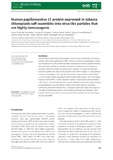Mostrar el registro sencillo del ítem
Human papillomavirus L1 protein expressed in tobacco chloroplasts self-assembles into virus-like particles that are highly immunogenic
| dc.creator | Fernández San Millán, Alicia | es_ES |
| dc.creator | Martín Ortigosa, Susana | es_ES |
| dc.creator | Hervás Stubbs, Sandra | es_ES |
| dc.creator | Corral-Martínez, Patricia | es_ES |
| dc.creator | Seguí-Simarro, José M. | es_ES |
| dc.creator | Gaétan, Julien | es_ES |
| dc.creator | Coursaget, Pierre | es_ES |
| dc.creator | Veramendi Charola, Jon | es_ES |
| dc.date.accessioned | 2019-01-16T08:07:58Z | |
| dc.date.available | 2019-01-16T08:07:58Z | |
| dc.date.issued | 2008 | |
| dc.identifier.issn | 1467-7644 (Print) | |
| dc.identifier.issn | 1467-7652 (Electronic) | |
| dc.identifier.uri | https://hdl.handle.net/2454/31982 | |
| dc.description.abstract | Cervical cancer is the second most prevalent cancer in women worldwide. It is linked to infection with human papillomavirus (HPV). As the virus cannot be propagated in culture, vaccines based on virus‐like particles have been developed and recently marketed. However, their high costs constitute an important drawback for widespread use in developing countries, where the incidence of cervical cancer is highest. In a search for alternative production systems, the major structural protein of the HPV‐16 capsid, L1, was expressed in tobacco chloroplasts. A very high yield of production was achieved in mature plants (~3 mg L1/g fresh weight; equivalent to 24% of total soluble protein). This is the highest expression level of HPV L1 protein reported in plants. A single mature plant synthesized ~240 mg of L1. The chloroplast‐derived L1 protein displayed conformation‐specific epitopes and assembled into virus‐like particles, visible by transmission electron microscopy. Furthermore, leaf protein extracts from L1 transgenic plants were highly immunogenic in mice after intraperitoneal injection, and neutralizing antibodies were detected. Taken together, these results predict a promising future for the development of a plant‐based vaccine against HPV. | en |
| dc.description.sponsorship | This work was supported by Grants BIO2005‐00155 and CPE03‐022‐C5‐2 from the Ministerio de Educación y Ciencia and INIA (Spain). | en |
| dc.format.extent | 15 p. | |
| dc.format.mimetype | application/pdf | en |
| dc.language.iso | eng | en |
| dc.publisher | Wiley | en |
| dc.relation.ispartof | Plant Biotechnology Journal (2008) 6, pp. 427– 441 | en |
| dc.rights | © 2008 The Authors | en |
| dc.subject | Human papillomavirus | en |
| dc.subject | Plant vaccine | en |
| dc.subject | Plastid transformation | en |
| dc.subject | Tobacco | en |
| dc.subject | Virus-like particles | en |
| dc.title | Human papillomavirus L1 protein expressed in tobacco chloroplasts self-assembles into virus-like particles that are highly immunogenic | en |
| dc.type | info:eu-repo/semantics/article | en |
| dc.type | Artículo / Artikulua | es |
| dc.contributor.department | IdAB. Instituto de Agrobiotecnología / Agrobioteknologiako Institutua | es |
| dc.rights.accessRights | info:eu-repo/semantics/openAccess | en |
| dc.rights.accessRights | Acceso abierto / Sarbide irekia | es |
| dc.identifier.doi | 10.1111/j.1467-7652.2008.00338.x | |
| dc.relation.publisherversion | https://doi.org/10.1111/j.1467-7652.2008.00338.x | |
| dc.type.version | info:eu-repo/semantics/publishedVersion | en |
| dc.type.version | Versión publicada / Argitaratu den bertsioa | es |


